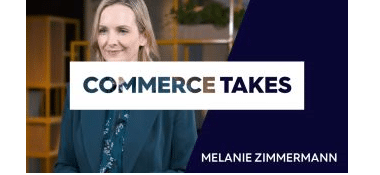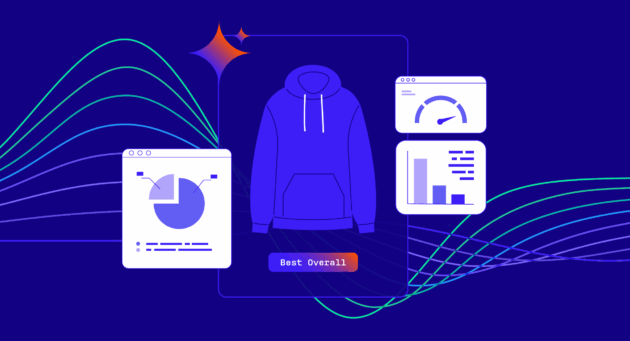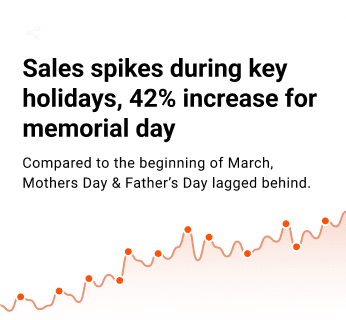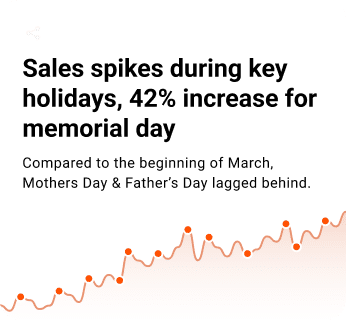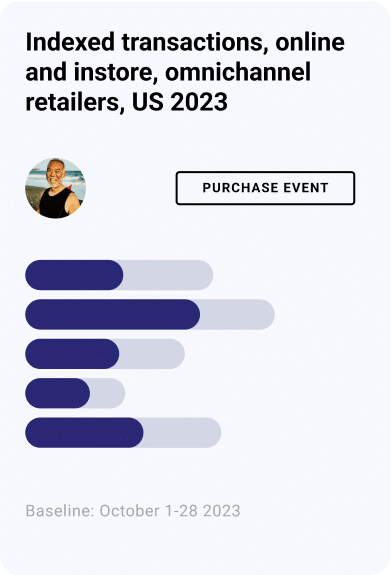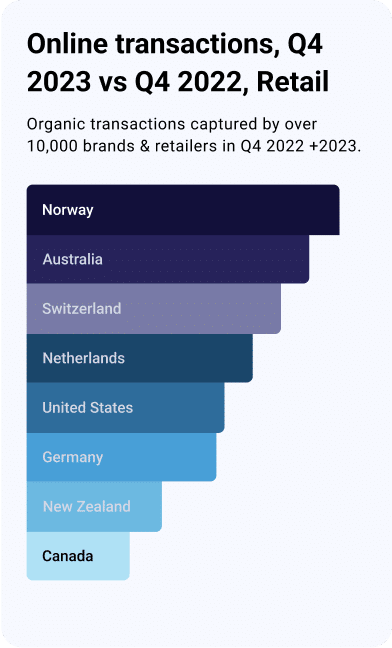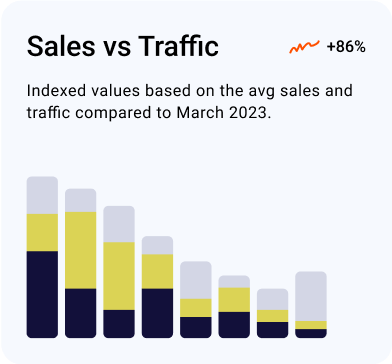The holiday shopping season is like a marathon for marketers—long, demanding, and requiring careful planning. With Black Friday kicking things off, there’s no time to lose. To get ahead, you need to know what worked last year, what’s changing this year, and how you can adapt your marketing strategies to make the most of it.
Black Friday Trends 2024: What to Expect
Let’s start by looking back. In 2023, Black Friday was massive, with a surge in online shopping across the US and Europe. Here’s a quick snapshot of last year’s Black Friday trends:
- US: Online sales on Black Friday were up 288% compared to average October 2023 sales. Cyber Monday saw a 258% increase.
- UK: Black Friday online sales jumped 289%, while Cyber Monday sales increased by 212%.
- France: Online transactions soared by 245%, with shopper spending up 264%.
- Germany: Online transactions climbed by 226%, with spending up 246%.
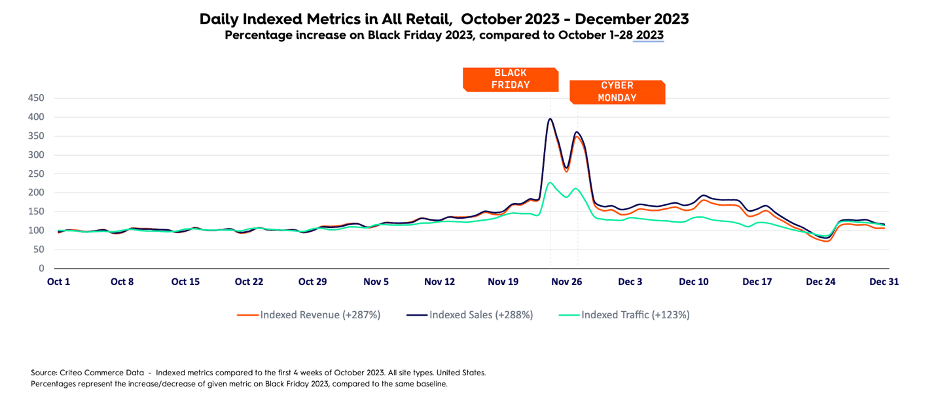
The top-performing product categories varied by country. For example, in the US, shoppers flocked to luggage & bags, apparel & accessories, and toys & games. Meanwhile, in the UK, health & beauty products stole the show alongside luggage and apparel. And in France and Germany, toys & games were top sellers, reflecting a diverse consumer landscape.
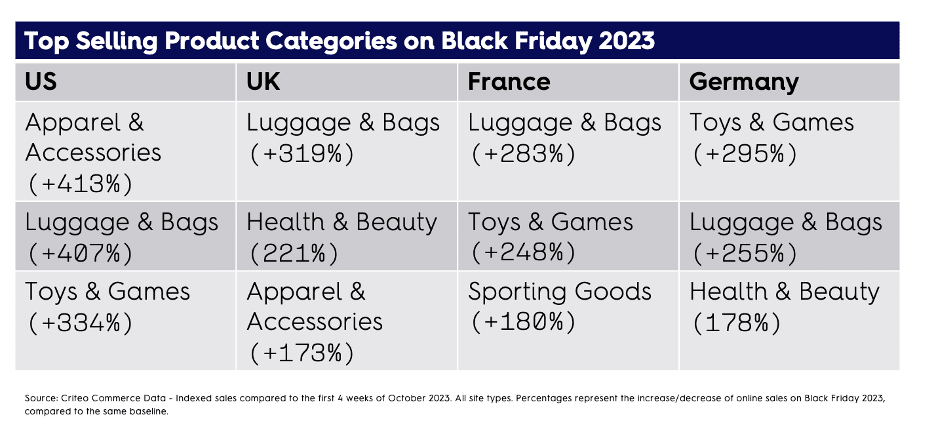
What’s interesting is the average time between a shopper’s first product page visit and purchase—17 to 18 days across the US and Europe. For the top quartile of shoppers, it can be as long as 44 to 45 daysI. This means that consumers start researching and planning their holiday shopping well in advance, emphasizing the need for marketers to get in front of them early.
In terms of shopping behavior, mobile commerce is becoming the favorite channel, with more than half of purchases during Cyber 6 (Black Friday through the following Wednesday) taking place on mobile across the US (59%) and Europe (65% in the UK, 53% in France, and 61% in Germany)II. The share of mobile transactions varies slightly by category in the US, with Fashion and Health & Beauty seeing a higher percentage. And for US omnichannel retailers, the share of in-store purchases was up 5% year-over-yearIII. This shows that a multi-channel approach is key to reaching today’s holiday shoppers.
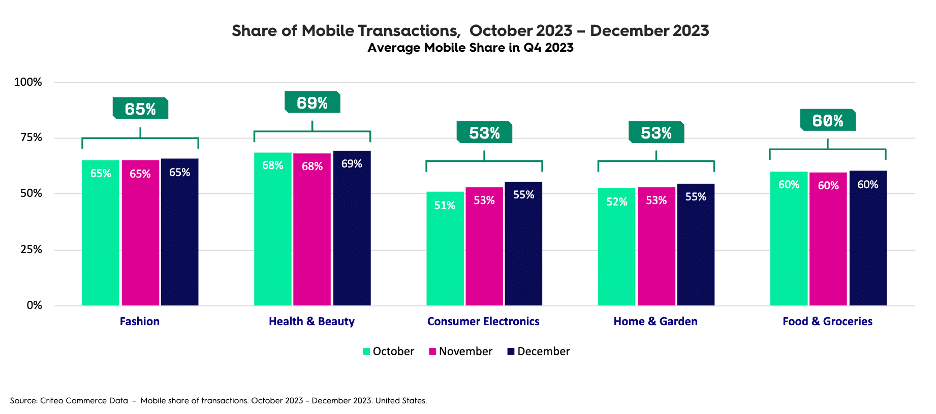
Black Friday Marketing Strategies to Boost Sales
So, what worked last year, and how can we use those learnings for 2024? Here are a few key strategies to incorporate:
- Start Early: “When to advertise for Black Friday?” is a perennial question. The answer is early – and getting earlier every year. Consumers start their holiday shopping research well before Black Friday. Plan to launch your campaigns at the beginning of October to reach those shoppers who take the longest to decide. Early engagement can be the difference between winning the sale or losing out to a competitor.
- Optimize Throughout Q4: Keep a close eye on performance and adjust your campaigns in real-time to maximize results. It’s essential to make ongoing optimizations, but be sure to make discrete changes so that the learnings are crystal clear.
- Budget Wisely: Daily budgets are crucial to avoid running out of steam before the big days. Also, Q4 isn’t just about immediate sales—this is a chance to attract new customers. Though competition and costs might be higher, the increase in average order value (AOV) and new customer rates makes it worth the investment.
- Increase Ad Spend: The holiday season, particularly Q4, is a time to increase budgets. With heightened competition, it’s essential to capitalize on increased buyer intent and AOV to maximize your return on ad spend.
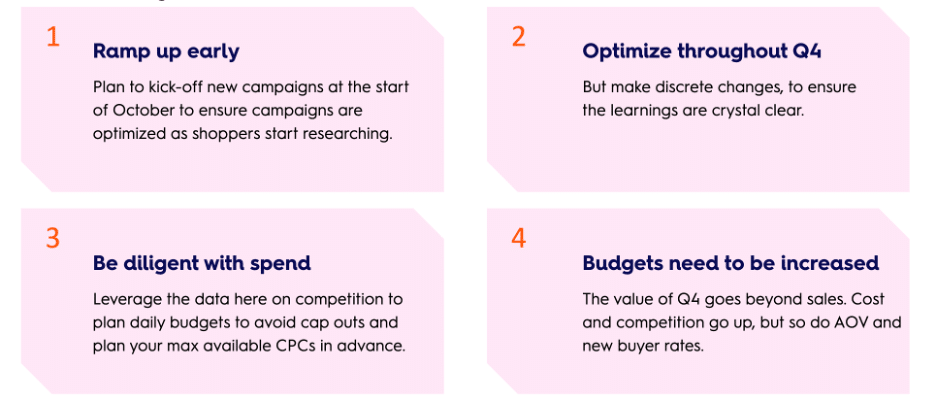
Key Advertising Techniques
The biggest sales season of the year is about more than just one or two days—it represents several months of heightened opportunity for marketers who know how to make the most of it. Marketers need a plan that attracts new customers early and makes full use of existing customers throughout the season while adjusting ads and messages based on key moments, like big sales or last ship dates.
To maximize Q4, marketers should plan their advertising for three main phases:
1. Several Weeks Before Black Friday: Acquisition is Key
Target in-market shoppers and new customers with a combination of audience segments:
- In-Market Audiences: Engage shoppers who are already actively browsing specific brands or products. Refine this with purchasing power or gender affinity.
- Lookalike Audiences: Reach new potential customers who resemble your top spenders.
- Prospecting Audiences: Target people showing active shopping intent.
- Retailer Audiences: Use first-party intent and purchase data from retailer websites.
In terms of messaging, experiment with early deals or special promotions. For example, use phrases like “Sign up to be notified about our mega discount!” to collect first-party data and build anticipation.
These acquisition campaigns will pay off during the holiday and well into the next year.
“Our research shows that more than a third of customers acquired during Q4 return to make another purchase in the following six months.”IV
2. A Few Weeks Before Black Friday/Cyber Monday: Engage Existing Customers
Use your first-party data to re-engage seasonal shoppers:
- Historical Shoppers: Bring back those who bought from you last holiday season.
- High Lifetime Value Customers: Reward your best customers with cross-sell and upsell opportunities.
- Discount Shoppers: Use rewards or special offers to convert deal-seekers.
- Loyalty Program Members: Inspire your loyalists with unique reward offers.
- Messaging during this period should emphasize deals and discounts, building excitement with countdowns, and personalizing product recommendations.
3. Post Black Friday/Cyber Monday: Keep the Momentum Going
Don’t let up after Black Friday. Continue targeting the same audiences and tap into last-minute shoppers who missed earlier deals. Promote store locations and buy online, pick up in-store (BOPIS) options to cater to those who can’t get items shipped in time. Create urgency with countdowns and highlight last-chance deals.
The Ultimate Black Friday Checklist for Marketers
To help you cover all your bases, here’s a quick checklist to ensure you’re ready for the holiday rush:
Performance:
– What are your main goals and KPIs for the season?
– How will you measure success?
– Do you have flexibility in your KPI targets?
Campaigns:
– Have you planned campaigns for each phase of the season?
– Are you accounting for retailer promotions and early season sales?
– Are there new product launches that need special attention?
Budget:
– Have you set budgets for each stage of the holiday season?
– Is there room to secure additional investment based on performance?
Here’s an at-a-glance calendar view of the key tasks and deadlines to launch and execute a successful holiday marketing campaign:
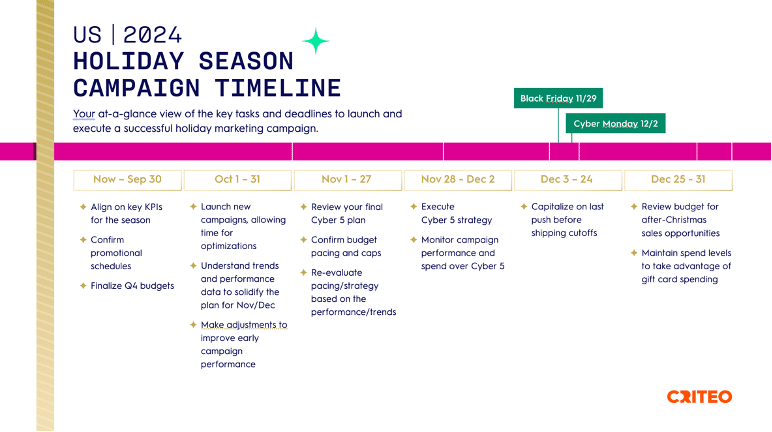
Keep Your Foot on the Gas Post-Season
When the holiday season wraps up, don’t let your marketing efforts go cold. Use the first-party data you’ve collected to keep customers engaged year-round. Build custom audiences, continuously engage lookalike audiences, and use key moments—like brand campaigns or product launches—to keep the momentum going.
In short, to dominate Black Friday 2024, you need a mix of early planning, strategic ad spend, and smart audience targeting. But it doesn’t end with the holidays—set yourself up for continued success into the new year!
[I] Source: Criteo Commerce Data – Time between a first visit and a completed transactions for sales completed during the Black Friday weekend (Friday to Monday). All site types. All Retail.
[II] & [IV] Source: Criteo Commerce Data – All Retail, Mobile and Desktop (App excluded). Cyber 6 (Friday to Wednesday), 2023 vs 2022. United States, UK, France, Germany.
[III] Source: Criteo Commerce Data – Retailers with a consistent tracking of online and instore transactions in November 2022 and 2023, United States


